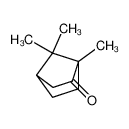
CAS No.: 464-49-3 Formula: C10H16O
Weight: 152.23300
Synonyms: d-camphor; 2-Bornanone 2-Camphanone; D-(+)-Camphor; (+)-CaMphor; (1R,4R)-1,7,7-trimethylbicyclo[2.2.1]heptan-2-one
Camphor, IUPAC name 1,7, 7-trimethyldicyclic [2.2.1] heptane-2-one, is a terpenoid organic compound that is white or transparent waxy solid at room temperature and can be used to repel insects. Camphor is extracted from camphor trees, and the older the trees, the more camphor they contain. The method of extraction is to cut the tree trunk into small pieces and distilled with water. The camphor oil is heated and rises with water vapor. It is formed when it comes into contact with a pre-placed pottery jar and cools. The early northern forests of Taiwan are mostly primitive camphor forests, and there are many old camphor trees more than a thousand years old. After the Japanese government cut down a large number of camphor exports in Taiwan, therefore, Taiwan's camphor output once reached the first place in the world, known as the "camphor kingdom". Most of the mothballs used in the world are synthesized by chemical methods.